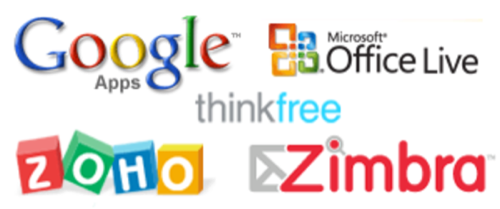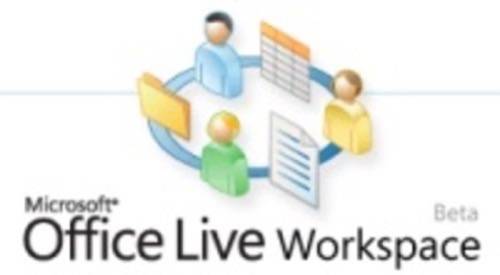
Over the next few weeks we’ll be reviewing a number of Web product categories on Read/WriteWeb, summarizing what’s happened in 2007 – and what to look forward to in 2008. We’re starting with the Web Office, a market that underwent a lot of changes this year. Our definition of Web Office is: A Web Office suite is a combination of productivity, publishing and collaboration features. A Web Office both embraces the functionality of desktop office suites (e.g. Microsoft Office) and extends it by using Web Native features.
Probably the biggest change was that Google Apps ramped up this year, starting with the release of Google Apps Premier in February. And 2007 continued the trend of acquisitions in this market, which started in 2006 with the likes of Writely and JotSpot. In 2007 Yahoo acquired Zimbra and Google acquired a number of small startups – including GrandCentral (online telephony service) and Zenter (presentations software).
The biggest disappointment of the year in Web Office? The lack of a compelling web-based offering from Microsoft. Perhaps not surprising, given Microsoft’s stranglehold on the desktop with Microsoft Office. But disappointing nonetheless.
So let’s explore Web Office in 2007 in depth….
Google Apps – the Leading Web Office Suite
2007 was a very busy year for Google in Web Office. They made a number of important acquisitions, and just as importantly developed their product range and continued integration of those into Google Apps.

In February, Google released a premier edition of its Google Apps package (previously known as Google Apps For Your Domain). They also unified the product range more, including a re-designed online control panel.
Up till this release, Google Apps only included Gmail, Google Talk, Google Calendar, Page Creator and Start Page. However the premier edition added Google Docs & Spreadsheets, a significant edition considering that word processing and spreadsheets are mainstays of Microsoft Office. Also added were a set of APIs and third party services, and a solid support and hosting package. However at that point there was no presentations app, CRM, or any sign of 2006 acquisition JotSpot. Also lacking was full integration and collaboration between the apps.
Other changes during the year to Google Apps: in June 2007, email migration from IMAP email services was added. In July, Google acquired GrandCentral and then a week later it announced its acquisition of Postini – a company that offers “on-demand communications security and compliance solutions serving more than 35,000 businesses and 10 million users worldwide.” Later the Postini services were integrated into Google Apps Premier Edition. In September, Google released Presently, its powerpoint competitor. In October, Google announced that e-mail storage for domains using Google Apps would be increasing – Premier accounts were raised from 10GB to 25GB each, while the Standard and Education Edition accounts were set to mirror the Gmail counter (previously 2GB, 3.77GB as of October 19, 2007).
In September, Google announced its first major partnership for Apps, with major IT consultancy and outsourcing specialist CapGemini. The agreement was for CapGemini to sell Google Apps to enterprises. CapGemini, which is also a partner of Microsoft and IBM, will keep the $50 per user fee that Google charges for Google Apps Premier Edition — they will also make money off services. Google positioned this news as Google Apps being a complement to Microsoft Office. Even so, the news elicited an interesting response from Microsoft, which issued a 10-point list of reasons enterprises should not adopt Google Apps. It was noticeable however that the list didn’t mention the word “collaboration”, which is probably the key benefit of Google Apps compared to MS Office. Microsoft wasn’t the only one though, Zimbra took a shot at Google Apps too (pre acquisition by Yahoo!).

Perhaps the biggest piece of the Web Office puzzle still missing from Google circa 2007 is what they’re doing with JotSpot, the wiki/spreadsheet product it acquired in October 2006. There were rumors in September this year and again in December of an upcoming wiki / intranet product from Google (Google Sites?), based on JotSpot. But no official word yet.
Also noteworthy, Sun’s StarOffice suite of productivity tools was added to the free Google Pack offering in August.
What’s Microsoft Doing in Web Office?
Not a lot, at least not publicly. Microsoft seemed mostly content to sit on its huge lead in the desktop office software, in 2007, offering little in the way of browser-based Web Office functionality. Its Office Live product is a cobbled together service of hosting plus basic products like email and webpage creation. But to be fair, that’s all Microsoft really needs to do at this point. As Emre Sokullu nicely put in a November post surveying the Web Office landscape, “Microsoft’s vision [for Web Office] is evolutionary, rather than revolutionary.”

However there were signs of life in October, when Microsoft announced a new online office service called Office Live Workspace, plus re-named its Office Live service to Office Live Small Business. Both moves were attempts to complement Microsoft Office, its dominant desktop office suite – rather than replace functionality present in MS Office. Also in October, Microsoft announced partnerships with Atlassian and Newsgator, two leading Web Office vendors, in a bid to make its Sharepoint product more ‘web 2.0’.
In August, it was reported that Microsoft will offer a free, ad supported version of Microsoft Works, its ‘lite’ office suite. It will be a desktop app and it will be distributed via pre-installing it on PCs – a tried and true Microsoft business model. Adverts will run within the programs, including the flagship word processing and spreadsheet apps.
September: Zimbra Acquired by Yahoo
A somewhat surprising acquisition in Web Office this year was Yahoo’s purchase of open source Web Office vendor Zimbra for $350 million, in September. Zimbra was an early force in bringing AJAX to the enterprise and adoped an RIA model in March, including both online and offline modes. So why did Yahoo!, a consumer focused company, but an office software company?

In a follow-up analysis post, we attempted to answer that question. We wrote that Yahoo is aiming to create a more open platform, using APIs and mashups across multiple Yahoo properties (e.g. Yahoo Maps). Yahoo executive Brad Garlinghouse wrote in a post at the time that he sees “great opportunities to incorporate some of their [Zimbra’s] best-of-breed features (I really like their calendaring) into Yahoo!Äôs industry-leading communications products.” We concluded that Yahoo will probably never be a full enterprise software company, as Google wants to be, but there is a lot of potential revenue in an email/calendar suite for small businesses and consumers in general.
See also our interview with Zimbra co-founder and CEO Satish Dharmaraj in October – available as a 30 minute podcast available on Read/WriteTalk (transcript included). It explores Zimbra’s journey from October 2005 Web 2.0 Conference launch to September 2007 acquisition by Yahoo!.
Zoho & ThinkFree Steadily Expand
Probably the two leading independent Web Office suite vendors are Zoho and ThinkFree – and both continued to expand their product range this year.
Zoho is arguably the most complete and full-featured Web Office suite on the market. In June Zoho told us that the Zoho Office Suite has “about 50% more apps” than Google Apps. Throughout the year the company announced a steady stream of new products and upgrades. Highlights included Zoho Notebook in May, offline functionality for Zoho Writer (using Google Gears) in August, a launch pad for Zoho’s suite of office applications called Zoho Start in late August, and the launch of an online database in November. Also for the first time Zoho released an official suite, similar to Google Apps, called Zoho Business. This suite could hold the key for Zoho going forward, as it continues to integrate its many products and features into a compelling whole.

ThinkFree has also been growing steadily and adding new products/features. ThinkFree markets its office suite as the one with best Microsoft Office compatibility. It is also mainly a Java-based solution, rather than Ajax which Zoho and Google predominantly use. ThinkFree Online includes three applications Äì ThinkFree Write for word processing, ThinkFree Calc for spreadsheet management and ThinkFree Show for creating presentations.

In February ThinkFree announced they’d reached 250,000 registered users. These users are made up of small and medium business owners and their staffs, university professors, teachers, entrepreneurs, parents, bloggers and students. ThinkFree users come from more than 200 countries, but the greatest number of users come from five regions: the United States, South Korea, Brazil, the United Kingdom and Canada. In August ThinkFree announced it had hit the 1 Million mark in number of hosted documents and was up to 335,000 users. At the same point in time, Zoho had 310,000 users (but claimed a faster growth rate).
Other Big Players: Salesforce, Adobe, Facebook
Salesforce.com was busy as ever – e.g. a new product called Salesforce ContentExchange, a content management product for unstructured data such as email and html.
In late Spetember Adobeacquired Waltham, Mass.-based Virtual Ubiquity for an undisclosed sum, and in doing so officially entered the web office fray. Virtual Ubiquity were the creators of Buzzword, an online, collaborative word processing application powered by Adobe’s Flex framework. It runs cross-browser in the Flash player.

Could Facebook be a platform for office apps? We listed our Top 10 Facebook Apps: Work in July, but at that time there was no way to create a cohesive groupware environment in Facebook. The best we could come up with was to use a private group to keep everyone in the loop, use 30 Boxes’s Calendar app to share important dates, and Zoho’s Online Office app to share documents. Hardly a Basecamp killer. However in November a new application was launched from DivShare, called Projects. Basecamp it is not, but there is hope yet for Facebook and office apps.

We shouldn’t also forget other big enterprise players, like IBM, Oracle, SAP and BEA. These bigcos continue to scrap it out in the large scale enterprise space – and web 2.0 features and philosophies became increasingly prominent in their product offerings in 2007. Incidentally I just love the photo to the right, by Scott Beale of Laughing Squid, of IBM staff in red shirts at this year’s Web 2.0 Expo!

Other Web Office Contenders
There are a lot of innovative and new types of Web Office products being built currently. Here are a couple we covered this year…
Clever Tools is a new online project management and extranet application suite that is aiming for a Q1 2008 launch (and a beta of at least a few of the apps in the suite in October of this year). The full Clever Tools suite will include a project management application (that includes message boards, task management, and file sharing), an invoicing app, timesheets, a CRM application, bug tracking, and a whiteboard.

Egnyte is a collaborative document sharing app that is like a mix between an online storage solution (such as Omnidrive or ElephantDrive) and a content management solution. In enterprise speak, essentially it’s a knowledge management application. The company started in January 2006 and launched the Egnyte private beta in May/June ’06. It launched its public beta around the time of Web 2.0 Expo, in April 2007.

There are many more apps we could mention, but way too many to cover in one post! Some other Web Office products we profiled this year: EditGrid, CentralDesktop, WebEx, ContactOffice, ShareOffice, Peepel, LiveDocuments.
Roll Yer Own Suite
As indicated above, there are multiple specialist apps that can be used instead of a suite like Google Apps. Josh Catone listed 10 Must Have Online Office Apps in late August, during Read/WriteWeb’s Web Office Week. It was a kind of sequel to his Rolling Your Own Online Office post from June.
Check out Josh’s choices for the best of breed online word processor, spreadsheet, presentation tool, calendar, email app, groupware, file storage, RSS reader, contact manager, and to do list.
Mobile Office
Devices like Blackberry have been used by IT departments in their office software for a while. But with the launch of the iPhone in June, it was almost inevitable that some Web Office vendors would create apps for iPhone.

For example CRM provider Etelos – which had already embraced other popular Web platforms like Google Apps, Netvibes, Pageflakes and Windows Live – announced a suite of modularized CRM tools for use on the iPhone. It already worked on the Blackberry, but Etelos’ Eric Berto said at the time that “the browser for the iPhone is much better than the BlackBerry”.
A Dark Horse: Meebo
As Emre Sokullu noted in November, meebo is one of the most successful online instant messaging clients,
but with their announcement of a platform there now exists the potential for a lot of development to occur around their user base. By allowing third-parties to tap into meebo’s communication platform and users, the company’s new development platform could actually be used to create intriguing web office applications. Below is a mockup of what a meebo platform app might look like:
The picture above imagines Google Presentations embedded into meebo.

Conclusion
So 2007 has been a very busy year in Web Office. Due mostly to its bulk and money, Google has stole a march on all the small startups that first got into the space back in 2004-5. In a June poll, we asked which online collaboration platform do you use? With over 1,500 respondents, Google Apps was way out in front — 47% of respondents use it. Basecamp was next with 18%, with Zoho on 10% and ThinkFree 8%. The two Microsoft options, Office Groove and Office Live, got only 2% each.
In 2008 we expect to see Google Apps mature into a more complete and functional suite, something that can take on Microsoft Office. Right now it isn’t quite ready for the enterprise, due to issues like functionality, security and compliance – all of which Microsoft Office is better in.
Also expect to see more acquisitions in 2008, as the smaller players jostle to either get their share of the office software pie – or perhaps win a golden ticket and get acquired by Google or another bigco. Partnerships are also key with the smaller players, because of corporate IT’s preference for big vendors.
The big question though is how Microsoft will counter the growinng threat of browser-based office software. They stayed relativfely quiet on this front in 2007, so maybe 2008 will be when they rise up to the challenge of Google Apps.










